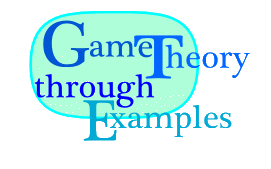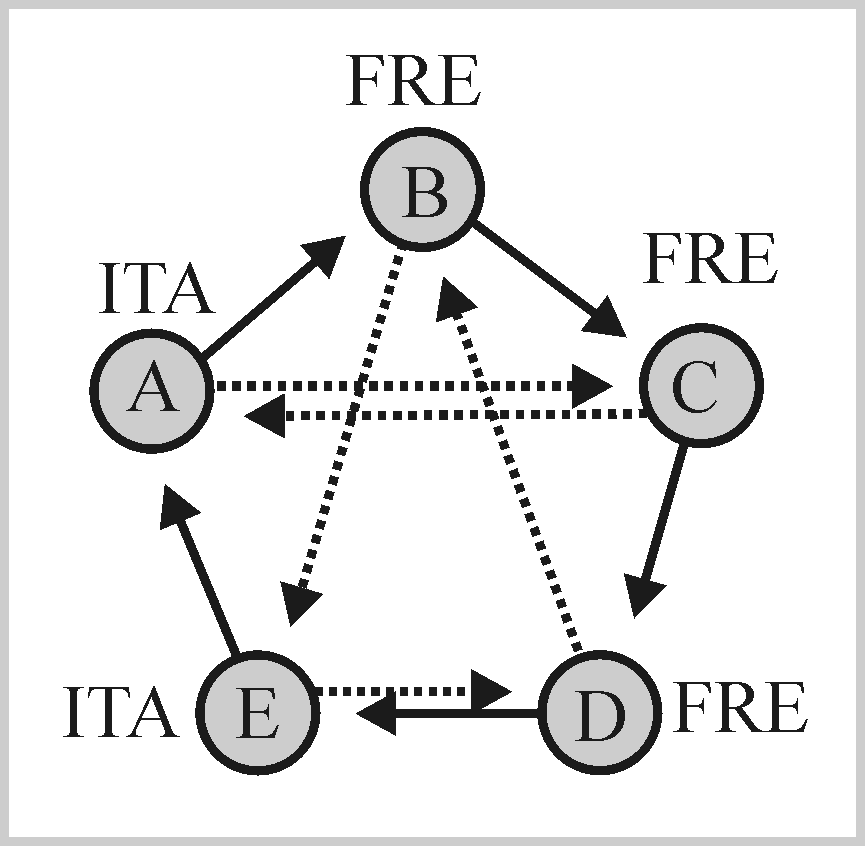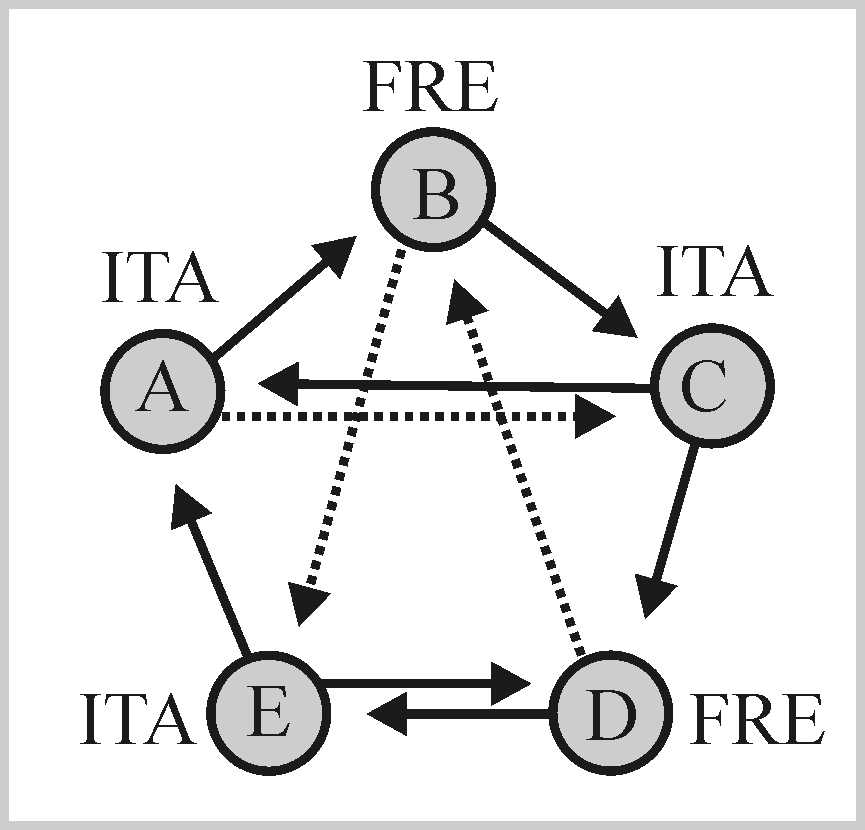
Selecting Class
Note to the Teacher: ...................
Here is an
Excel sheet
Prerequisites: Chapters
1 and
2.
All students in Soap College have to either enroll into FRE100 or ITA100 in their
second semester.
We assume that every student prefers one of these two courses.
There is a group of students, however, the so-called "Drama Queens and Kings",
which have a strong pattern of love and hate between their members,
and for which it is most important to be in a class with many group members
they love and with few group members they hate. To be more precise, the difference
of loved members in the same class and hated members in the same class is what counts.
Only if this difference would be the same for both classes, these drama queens or kings
would decide according to their personal preference to the course and language itself.
The dean is concerned that many of these group members will end in a class they
wouldn't have chosen but for interpersonal reasons, and assigns the task to investigate to us.
Note that there is no love or hate from group members towards other students,
only love and hate within the group. But group members could also be indifferent
towards other group members. We can model the game by assuming that each group member gets a payoff
of 9 for every group member he or she loves who ends in the same class, and a payoff of -9
for every group member he or she hates who ends in the same class, and an additional payoff of 1
if he or she gets she course she has a slight preference. The total payoff for every group member
is the sume of these numbers.
We will discuss several examples in this chapter,
mostly where the group of drama queens and kings consists just
of three persons, but also for 5-student groups. Finding Nash equilibria
in 3-player games is practiced, but
the class activities should also provide a very direct hands-on
impression of the method to find Nash equilibria for any number of
players by best response dynamics. This is the only part in the book
where a game for more than three players is discussed briefly.
Of course there are many variants of the game, depending on love, hate,
and indifference between the three players, and also the preferences of the three
players for Italian or French. This is called the data. For a given love/hate pattern, there are eight
possibilities, eight different games, of class preferences of the three players.
We will discuss all these eight games for different love/hate patterns
in different sections.
1. "I love you both"
The three group members are Adam, Beth, and Carl,
and there is mutual love between Adam and Beth, as well as between Beth and Carl.
There is no hate (yet) in this group.
1.1 Adam and Beth prefer French and Carl prefers Italian
Class Activity:
Three students should role-play Adam, Beth, and Carl,
using that love/hate pattern, where Adam and Beth prefer French and Carl prefers Italian.
Reserve one corner of the classroom for FRE100 and another one for ITA100.
Students should tentatively move to the area they prefer. When everybody has tentatively
placed, each student should think about the two options, given the present location of the other two,
and the love/hate and class preferences he or she should simulate,
and should move if this implies improvement.
At some point no student will want to move anymore.
This is a Nash equilibrium then.
The payoff matrices look as follows, with best responses in bold and
Nash equilibria colored.
| A chooses FRE100 |
| |
C chooses FRE100 |
C chooses ITA100 |
| B chooses FRE100 |
10, 19, 9 |
10, 10, 1 |
| B chooses ITA100 |
1, 0, 0 |
1, 9, 10 |
|
| A chooses ITA100 |
| |
C chooses FRE100 |
C chooses ITA100 |
| B chooses FRE100 |
0, 10, 9 |
0,1,1 |
| B chooses ITA100 |
9, 9, 0 |
9, 18, 10 |
|
Thus this game has two Nash equilibria, with all players selecting the same class.
If all choose French, then two have chosen the class they should go (according to the
dean who has only academics in mind), and if all choose Italian, one has done the right choice.
On average we have 1.5 right choices, which is not better than random.
1.2 Other class preferences
It doesn't really matter which classes Adam, Beth, and Carl prefer.
Depending on these preferences, the payoff matrices are
| A chooses FRE100 |
| |
C chooses FRE100 |
C chooses ITA100 |
| B chooses FRE100 |
9+ε, 18+ε, 9+ε |
9+ε, 9+ε, 0+ε |
| B chooses ITA100 |
0+ε, 0+ε, 0+ε |
0+ε, 9+ε, 9+ε |
|
| A chooses ITA100 |
| |
C chooses FRE100 |
C chooses ITA100 |
| B chooses FRE100 |
0+ε, 9+ε, 9+ε |
0+ε, 0+ε, 0+ε |
| B chooses ITA100 |
9+ε, 9+ε, 0+ε |
9+ε, 18+ε, 9+ε |
|
where ε is not a variable but rather indicates that we add a small number of 0 or 1,
depending on whether the student is in the "right" class.
The bold black numbers are best responses. The bold red numbers could be best responses, but
don't have to, depending on the class preferences of the players
(thus depending on which εs are 0 and which are 1). But no matter whether
they are or not, we just get the two Nash equilibria of all three students going to the same class.
Of course, for this analysis we would not really need the matrices. Just look at
the class activity above. If Adam or Carl are tentatively not in the same class as Beth,
they will move, not matter what class they would slightly prefer. Beth may also move, but
at most once, in case Adam and Carl are presently in different classes and Beth is not in
she class she would slightly prefer. Since Beth eventually settles, Adam and Carl will move
to the class where Beth finally is, and will settle there as well. All three resting
means we have a Nash equilibrium.
Thus the disappointing outcome for the dean is: In this "I love you both" case,
on average only 50% of the students will end in a class they would prefer if no
personal feelings were involved.
2. Hating the rival
The three group members are Adam, Beth, and Carl,
and there is mutual love between Adam and Beth, as well as between Beth and Carl,
and mutual hate between Adam and Carl.
Class Activity:
For this love/hate pattern,
students should try the above simulation where Adam and Beth prefer French and Carl prefers Italian.
Class Activity:
Now try the above simulation where Adam and Carl prefer French and Beth prefers Italian.
2.1 Adam and Beth prefer French and Carl prefers Italian
| A chooses FRE100 |
| |
C chooses FRE100 |
C chooses ITA100 |
| B chooses FRE100 |
1, 19, 0 |
10, 10, 1 |
| B chooses ITA100 |
-8, 0, -9 |
1, 9, 10 |
|
| A chooses ITA100 |
| |
C chooses FRE100 |
C chooses ITA100 |
| B chooses FRE100 |
0, 10, 9 |
-9, 1, -8 |
| B chooses ITA100 |
9, 9, 0 |
0, 18, 1 |
|
In this scenario, everybody goes to the class he or she should attend
according to the dean.
2.2 Adam and Carl prefer French and Beth prefers Italian
| A chooses FRE100 |
| |
C chooses FRE100 |
C chooses ITA100 |
| B chooses FRE100 |
1, 18, 1 |
10, 9, 0 |
| B chooses ITA100 |
-8, 1, -8 |
1, 10, 9 |
|
| A chooses ITA100 |
| |
C chooses FRE100 |
C chooses ITA100 |
| B chooses FRE100 |
0, 9, 10 |
-9, 0, -9 |
| B chooses ITA100 |
9, 10, 1 |
0, 19, 0 |
|
We get three Nash equilibria. All three cases where two of them go where they
should go according to their class preferences, and the third one does not are possible.
If Beth stays in French, then it is because both Adam and Carl are there.
If Adam chooses Italian, then the reason is that Beth takes it too whereas Adam does not.
And similar in the third case.
2.3 The other cases
If all three students prefer French, then all will go there. If Adam prefers French but
Beth and Carl prefer Italian, then also everybody will go to the class
he or she should go.
Overall, this "Hating the rival" would please the dean. In most cases,
students go where they, according to the dean, should go.
3. Outsider
Assume that Adam and Beth love each other, and that Carl loves both of them, whereas they both
hate Carl. A very awkward situation indeed, but not only for poor Carl,
but also for the game, as we will see.
Class Activity:
For this love/hate pattern,
students should try the above simulation where
Adam and Carl prefer French and Beth prefers Italian.
What happens is that we don't have any Nash equilibrium in this case.
So students will never stop moving in this simulation.
4. Five drama queens and kings

Assume there are five persons, A, B, C, D, E, with love from A to B, from B to C,
from C to D, from D to E, and from E to A, and with hate from B to E, from E to D, and from D to B,
and with mutual hate between A and C. Moreover B, C, and D have slight preferences for FRE100,
and A and E have slightly prefer ITA100. This data is indicated in the graph to the right,
where full arrows indicate love, dotted arrows indicate hate, and the slight class preferences are attached to the student names.
Note that every student loves one other student of the group, and hates another one.
This implies that in a distribution of the students to the classes, a student X
- wants to change classes if the hated one is in the same class, but the loved one is not, but
- is satisfied with staying if the loved one is in the same class, but the hated one is not.
- If both loved one and hated are in the same class, then X should follow her or his slight class
preference.
Class Activity:
For this love/hate pattern, five students
should try the above simulation.
Confirm that we get some Nash equilibrium if
B and C choose FRE100 and A, D, and E choose ITA100.
This is also the only one.
Do the students find it in the simulation?
More links
Exercises
- Cyclic Love: Investigate two different cases (based on their class preferences)
of the situation where Adam loves Beth, Beth loves Carl, and Carl loves Adam,
and otherwise there is indifference. Note that all this love is not returned.
...........
- Cyclic Hate: Analyze two different class-preference cases
of the situation where Adam hates Beth, Beth hates Carl, and Carl hates Adam,
and otherwise there is indifference, and none of this hates returned.
...
- Darling: Now assume Adam and Carl both love Beth, but Beth does not return these loves.
Analyze two different class-preference cases.
...
- Cyclic Love and Hate: Let's assume Ann loves Beth but Beth hates Ann (such things happen),
that Beth loves Cindy but Cindy hates Beth,
and that Cindy loves Ann but Ann hates Cindy.
Analyze two different class-preference cases.
...
 Are there any Nash equilibria if the group consists of 5 students
with the love/hate pattern and slight class preferences
as indicated in the figure to the right.
Are there any Nash equilibria if the group consists of 5 students
with the love/hate pattern and slight class preferences
as indicated in the figure to the right.
...
- .....
...
- .....
...
- .....
...
- .....
...
- .....
...
 Assume there are five persons, A, B, C, D, E, with love from A to B, from B to C,
from C to D, from D to E, and from E to A, and with hate from B to E, from E to D, and from D to B,
and with mutual hate between A and C. Moreover B, C, and D have slight preferences for FRE100,
and A and E have slightly prefer ITA100. This data is indicated in the graph to the right,
where full arrows indicate love, dotted arrows indicate hate, and the slight class preferences are attached to the student names.
Assume there are five persons, A, B, C, D, E, with love from A to B, from B to C,
from C to D, from D to E, and from E to A, and with hate from B to E, from E to D, and from D to B,
and with mutual hate between A and C. Moreover B, C, and D have slight preferences for FRE100,
and A and E have slightly prefer ITA100. This data is indicated in the graph to the right,
where full arrows indicate love, dotted arrows indicate hate, and the slight class preferences are attached to the student names.

 Are there any Nash equilibria if the group consists of 5 students
with the love/hate pattern and slight class preferences
as indicated in the figure to the right.
Are there any Nash equilibria if the group consists of 5 students
with the love/hate pattern and slight class preferences
as indicated in the figure to the right.